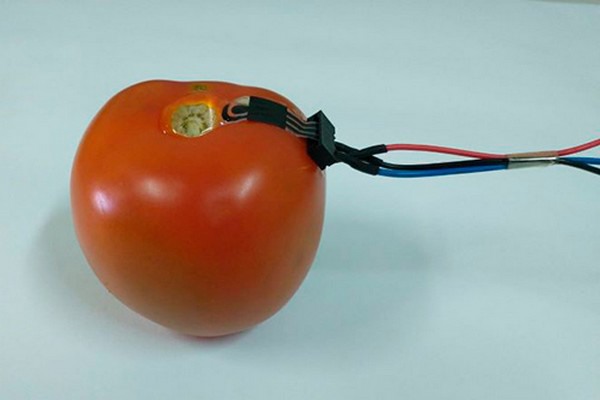Researchers at the University of São Paulo (USP) and the Federal University of Viçosa (UFV) in Brazil have developed a sustainable sensor that can be placed directly on the surface of a vegetable or fruit to detect the presence of pesticides. Known for this reason as “plant-wearable,” it is made of cellulose acetate, a material derived from wood pulp.
The device has the potential to help assure food safety in a world that increasingly suffers from a shortage of food and the environmental and health problems caused by excessive use of agrochemicals.
An article describing the results of the study is published in the journal Biomaterials Advances.
Pesticides are widely used to raise crop yields and are typically applied by spraying, but only 50% reach their target. The rest ends up in the soil, groundwater, surface water, raw drinking water, wastewater, and food products. Monitoring of pesticide levels in water, soil, and food is therefore essential to prevent contact between these toxic substances and the public via the skin, lungs, or digestive system.

The analytical tools most often used for this purpose are chromatographic techniques, which are effective but have drawbacks such as the need for pretreatment of samples, expensive equipment, and qualified laboratory specialists, as well as the long time taken to complete the analysis and lack of portability. The unsafe residues produced by organic solvents are also a significant problem under present-day conditions.
“As an alternative, electrochemical sensors can combine affordability, rapid detection, miniaturization, large-scale production, convenience, ease of use, high selectivity, and in situ pesticide detection. Our invention has all these features. The analysis is performed directly on the surface of fruit, vegetables, or leaves. Hence the term plant-wearable,” said Paulo Augusto Raymundo-Pereira, the last author of the article and a researcher at the São Carlos Physics Institute (IFSC-USP).
“However, instead of the usual materials, which are environmentally unsustainable and take a long time to degrade, such as ceramics or plastic polymers derived from petroleum, we used cellulose acetate, a material derived from plants that have little impact on the environment and disintegrates completely in 340 days or less depending on local conditions. Of course, it has to have appropriate characteristics for any sensor, including low cost, portability, and flexibility.”
The biodegradable cellulose acetate substrate was produced by a casting method in which the material was placed in a space with the required shape, and the full electrochemical system with three electrodes was deposited by screen printing.
The researchers carried out laboratory tests in which a solution containing carbendazim, a fungicide, and paraquat, a herbicide, was sprayed on lettuce and tomatoes in a simulation of real-world use. Paraquat was banned by the European Union in 2003 owing to its harmful effects on humans, but it is still used in Brazil. The sensor was then directly attached to the lettuce and tomatoes, and measurements showed a level of detection compatible with those obtained with polyethylene terephthalate, the sensor material most frequently used for this purpose.
Excessive pesticide levels
The study, which was funded by FAPESP (projects 20/09587-8, 23/07686-7, 16/01919-6, 22/02164-0, and 23/09685-8) also investigated whether washing and immersing vegetables in a liter of water for two hours was effective to remove pesticide residues. The results showed the removal of 40% of the carbendazim and, 60% of the paraquat from lettuce, and 64% of both from tomatoes.
“Washing and immersion were clearly insufficient to remove residues of the pesticides. At least 10% remained in the leaves or peel,” Raymundo-Pereira said.
The technology can be useful for sanitary surveillance agencies worldwide, he added, as well as sellers of organic produce to certify the absence of pesticides. Farmers generally can use it to monitor levels of pesticides in the field and be sure of applying only the requisite dose to each crop or part of a plantation. Pesticide use could decrease as a result, while yields will still rise, leading to lower consumer prices.
Source: agencia.fapesp.br
